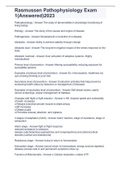Allostatic overload - Study guides, Class notes & Summaries
Looking for the best study guides, study notes and summaries about Allostatic overload? On this page you'll find 127 study documents about Allostatic overload.
Page 4 out of 127 results
Sort by
Rasmussen Pathophysiology Exam 1(Answered)2023

-
PATHOPHYSIOLOGY (PATHO) 370 FINAL EXAM STUDY GUIDE 2023 COMPLETE
- Exam (elaborations) • 58 pages • 2023
-
Available in package deal
-
- $15.49
- + learn more
PATHOPHYSIOLOGY (PATHO) 370 FINAL EXAM STUDY GUIDE 2023 COMPLETE. Considerations: culture, age, gender, situation, time. 9. Levels of Prevention: Primary: altering susceptibility or reducing exposure for susceptible persons (vaccination). Secondary: early detection, screening, and management of disease. Tertiary: rehabilitation, supportive care, reducing disability, and restoring effective functioning. 10.Subclinical: disease that has no recognizable clinical findings. Distinct from a clini...

-
PATHOPHYSIOLOGY (PATHO) 370 FINAL EXAM STUDY GUIDE 2023 COMPLETE
- Exam (elaborations) • 58 pages • 2023
- Available in package deal
-
- $18.49
- + learn more
PATHOPHYSIOLOGY (PATHO) 370 FINAL EXAM STUDY GUIDE 2023 COMPLETE. Etiology: study of causes or reasons for a particular injury. Idiopathic (unknown) vs Iatrogenic (unintended/unwanted medical treatment). Risk Factor: a factor that increases the likelihood of disease. 2. Pathogenesis: development or evolution of disease from initial stimulus to ultimate expression of manifestations of the disease. 3. Clinical Manifestations: Signs (objective) vs Symptoms (subjective). 4. Stages and Clinical ...
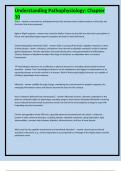
-
Understanding Pathophysiology: Chapter 10
- Exam (elaborations) • 6 pages • 2024
-
- $8.99
- + learn more
Telomere shortening or attrition is linked to biologic aging and can be accelerated by a number of conditions associated with: - answer-inflammation and oxidative stress T/F Stress has a minor role on telomere shortening - answer-False; Stress has a major role on telomere shortening that can begin in utero by increasing early telomere damage, inflammation, and greater rate of leukocyte division T/F Childhood stress predicts telomere erosion and heightened inflammatory repsonse to psychosoc...

-
Advanced Pathophysiology: Exam 1 2022 graded a
- Exam (elaborations) • 27 pages • 2022
-
- $13.49
- + learn more
Chapter 1: Introduction to Pathophysiology*: 2. Risk: Factor that when present increases the chance of disease Not stressors, but conditions or situations that increase the likelihood of encoun- tering a stressor 3. Prevalence: A measure of disease that allows us to determine a person's likelihood of having a disease. Therefore, the number of prevalent cases is the total number of cases of disease existing in a population. A prevalence rate is the total number of cases of a disease existing ...
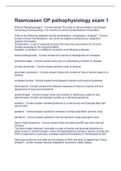
-
Rasmussen OP pathophysiology exam 1 with 100% Correct Answers 2023
- Exam (elaborations) • 12 pages • 2023
-
Available in package deal
-
- $10.49
- + learn more
What is Pathophysiology? - Correct answer-The study of abnormalities in physiologic functioning of living beings. it is in terms of common presentations of disorders. What is the difference between clinical manifestation, complication, sequela? - Correct answer-Clinical manifestations- can either be objective (physician) or subjective (patient) information Complication- a new or separate process that may arise secondarily b/c of some change produced by the original problem. Sequela- a con...
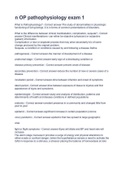
-
pathophysiology exam with correct answers
- Exam (elaborations) • 12 pages • 2023
-
- $8.49
- + learn more
What is Pathophysiology? - Correct answer-The study of abnormalities in physiologic functioning of living beings. it is in terms of common presentations of disorders. What is the difference between clinical manifestation, complication, sequela? - Correct answer-Clinical manifestations- can either be objective (physician) or subjective (patient) information Complication- a new or separate process that may arise secondarily b/c of some change produced by the original problem. Sequela- a ...
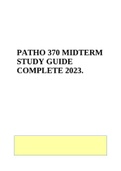
-
PATHO 370 MIDTERM STUDY GUIDE COMPLETE 2023.
- Exam (elaborations) • 63 pages • 2023
-
Available in package deal
-
- $15.49
- + learn more
PATHO 370 MIDTERM STUDY GUIDE COMPLETE 2023. PATHO 370 Pathophysiology. define stress and give examples of physical, chemical, emotional, direct, indirect, external, internal, positive, negative stressors Stress is a real or perceived threat to the balance of homeostasis. Stress response is to restore balance. Stressors are agents/conditions that are capable of producing stress and endangering homeostasis o Physical: extreme hot or cold temperature o Chemical: auto exhaust o Emot...
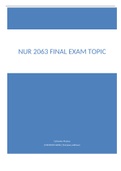
-
NUR 2063 Final exam Topics
- Exam (elaborations) • 22 pages • 2022
-
- $14.99
- + learn more
Final Exam Study Guide Module 1: STRESS – WHAT IS IT?, PURPOSE OF, WHAT DETERMINES RESPONSE? WHAT IS IT? – physical, chemical or emotional factor that results in tension of body or mind, real or perceived threat to homeostasis, can be positive or negative PURPOSE – WHAT DETERMINES RESPONSE – SELYE GAP SYNDROME STAGES, BODY’S RESPONSES TO STAGES – ALARM, RESISTANCE, EXHAUSTION: ALARM – the stressor upsets homeostasis or cellular balance; releases epi and norepi, and corti...
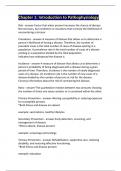
-
Chapter 1: Introduction to Pathophysiology
- Exam (elaborations) • 31 pages • 2023
-
- $12.49
- + learn more
Risk - answer-Factor that when present increases the chance of disease Not stressors, but conditions or situations that increase the likelihood of encountering a stressor Prevalence - answer-A measure of disease that allows us to determine a person's likelihood of having a disease. Therefore, the number of prevalent cases is the total number of cases of disease existing in a population. A prevalence rate is the total number of cases of a disease existing in a population divided by the to...

Do you wonder why so many students wear nice clothes, have money to spare and enjoy tons of free time? Well, they sell on Stuvia! Imagine your study notes being downloaded a dozen times for $15 each. Every. Single. Day. Discover all about earning on Stuvia

